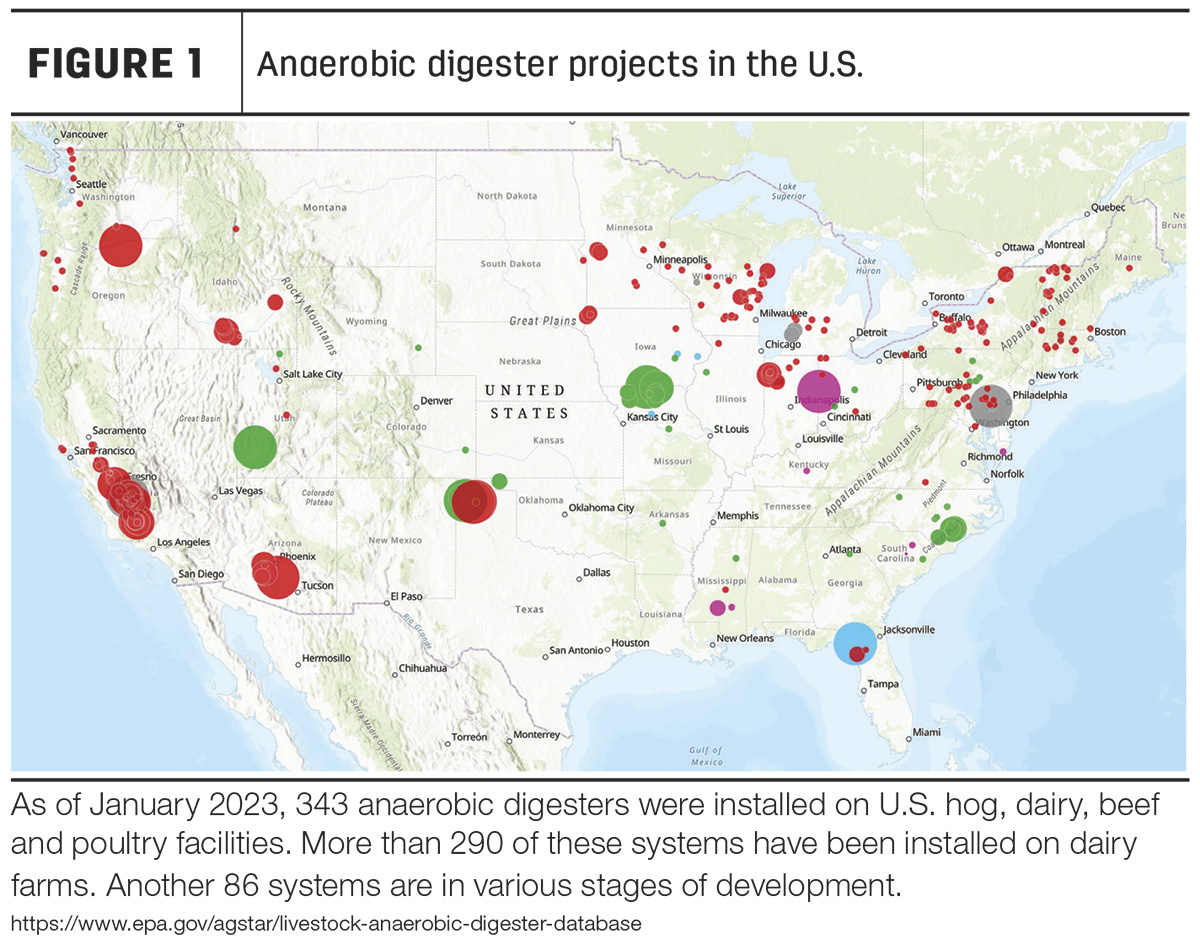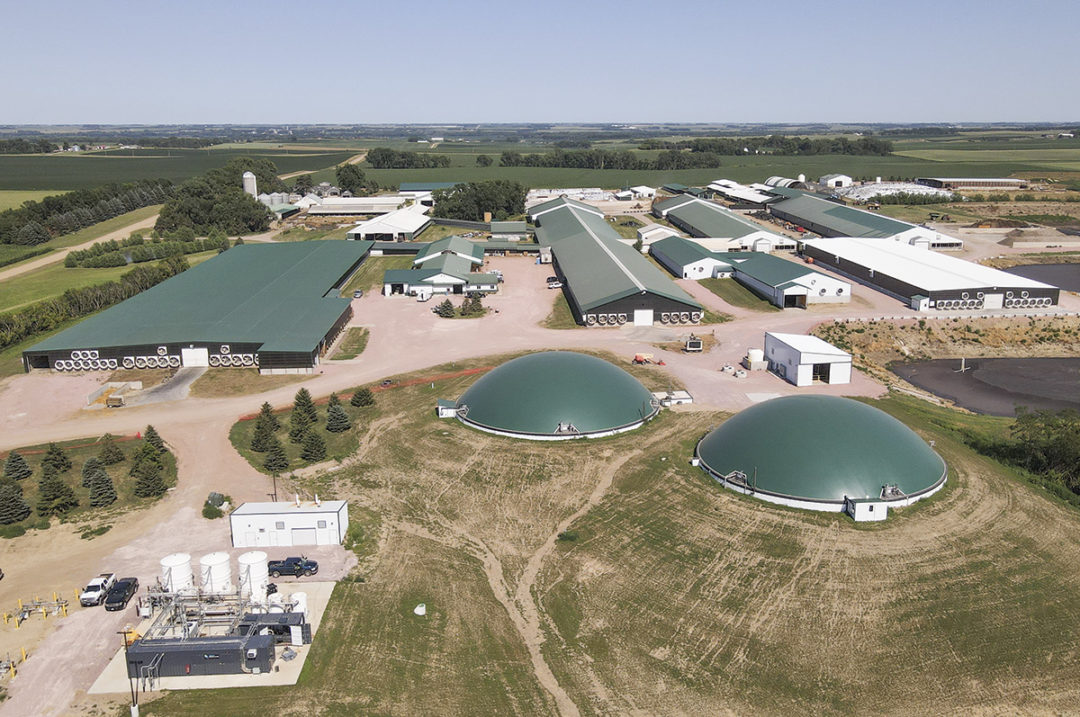Whether your objective is sustainability, a new revenue source or odor control, interest in and development of dairy anaerobic digester projects has swelled over the past few years.
The upward trend is only expected to increase as dairies seek manure solutions to meet a changing marketplace. Government estimates from earlier this year suggest anaerobic digester systems are feasible on 8,000 U.S. livestock farms, including dairy, potentially generating nearly 16 million megawatt hours (MWh) of energy per year.
Figure 1 shows the areas where digesters are currently located across the U.S.
 Additionally, state and regional carbon credit markets such as California’s Low Carbon Fuel Standard are creating revenue opportunities through the capture and sales of carbon credits gained by reducing greenhouse gas (GHG) emissions. Similar programs in other areas are coming online soon, piquing interest and opportunities with these systems.
Additionally, state and regional carbon credit markets such as California’s Low Carbon Fuel Standard are creating revenue opportunities through the capture and sales of carbon credits gained by reducing greenhouse gas (GHG) emissions. Similar programs in other areas are coming online soon, piquing interest and opportunities with these systems.
A digester journey is best accomplished with a strong roster of trusted advisers with a wide range of expertise. As a dairy owner, you cannot know everything about every step; you will need to lean into the knowledge and experience of others. Every situation is different because every dairy and every project is unique.
Use these suggestions to help assemble your team.
Lay the groundwork
First, it is essential to align your goals and objectives for a digester project with those for your dairy and your team. Share with your internal team and key business advisers why you have decided to take this step and what it means for the future of the farm business.
Keep in mind, adopting anaerobic digester technology for a dairy farm requires teamwork, time and patience. Your dairy team will need to deal with interruptions, changes and challenges, so everyone must be supportive of the project.
Digester projects are usually a long time in the making, often stretching 18 to 24 months or more, so you and your dairy must be prepared for the long haul.
Alignment with your dairy’s goals and additional team members is critical for success. It also ensures that you have built the right team of internal and external advisers. To help, be sure to define roles and expectations – who will be doing what, when – and put this in writing.
This step may seem intuitive or even unnecessary, but failure to communicate expectations and responsibilities can quickly derail plans and projects.
To further avoid transmission gaps, develop a communication plan within your farm team so third parties know who they must speak with to obtain information as the project gets underway. Your farm and digester teams need to know who is responsible for relaying information to decision-makers. Doing so helps cut down on communication gaps and misunderstandings between teams and partners.
Consider developing a community advocate from within your team or consulting with a public relations expert to help share your project’s story with your local community. Seek media communication training for key members of your team who will be speaking on your behalf.
Ask questions
Talk with peers, visit farms with existing systems and ask for referrals to build your network. Also, discuss project timeline expectations and learn from others when it is critical to bring in specific advisers.
For example, ask questions like: Should you loop in your local government officials before or after you have a site plan? What should you expect during the different phases of a project?
Get tips on how to best discuss plans with your lender and who should help negotiate with an energy company.
Generate a detailed, methodical list of questions to determine requirements for each step of the process. Assign timelines to each rule and associated activities to keep projects on track, meet regulatory deadlines and avoid surprises.
Create a team roster
The make-up of your team will likely ebb and flow as planning and construction progress, but a strong digester team often includes:
- Agronomists. Use their expertise for proper nutrient application, management and soil fertility. Their role is important as you work through manure application logistics.
- Equipment dealers/suppliers. Work with your local suppliers to determine which products and services you need to make your project a success.
- Engineering firms. They design your project and are involved from its inception. These experts are responsible for site preparation, design, construction, installation, inspections and more.
- Farm attorney/legal team. Consult with your farm’s attorney throughout a digester project. Involve them early and keep them engaged in the process to ensure your legal rights are protected and the responsibilities of involved parties are spelled out.
- Installation specialists. Electricians and other local installers are essential for timely and proper project setup, installation and maintenance. Be sure to involve them in the project early so they can have the personnel and supplies on hand to do the work.
- Irrigation specialists. Consider consulting with an irrigation specialist if you will be applying manure effluent via an irrigation system. Like agronomists, these specialists may not be part of initial decisions, but consider bringing their advice on board when you work through application logistics.
- Lenders. Financial professionals should already have a seat on your team. Be sure to share plans with them early in the development process. Keep lenders up to speed from the beginning to the end of a project.
- Local and state government officials. Know local, county and state siting regulations. Begin with local zoning boards to determine which governing bodies have jurisdiction over a project before you begin. These officials should be able to share which other government entities will need to be involved from a regulatory perspective, as well as the timing of their involvement.
- Manure management system specialists. Join with these experts to help understand and optimize manure volume, storage and transport throughout your farm’s facilities. Experienced guidance from these consultants is needed from a project’s inception to ensure a plan features the proper equipment to efficiently deliver manure to the digester and that it accomplishes your dairy’s needs today and tomorrow.
- NRCS personnel. NRCS can be a source of digester funding as well as provide federal regulatory guidance and practice standards for dairy farms. It’s important to involve NRCS personnel early in digester project discussions.
- State department of agriculture and natural resources personnel. Local officials, experienced digester and manure management personnel and NRCS experts should be able to help determine when state department of agriculture and/or natural resources officials must be part of your project team. Requirements likely vary by state, so be sure to ask about state involvement early in the process.
Ask your neighbors and peers for referrals if you do not already have a relationship with key experts.
Never underestimate the power of a good team and a good plan. Closely collaborate with your team to create, install and operate the best system to fit your needs today and into the future.
For more details about choosing a digester project team, check out this webinar.
References omitted but available upon request by sending an email to the editor.







